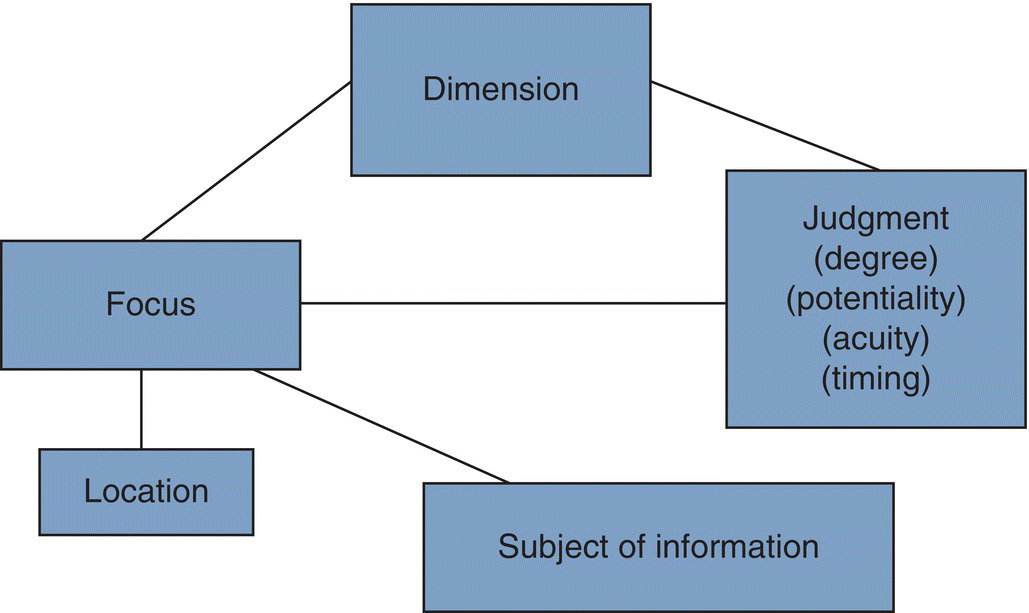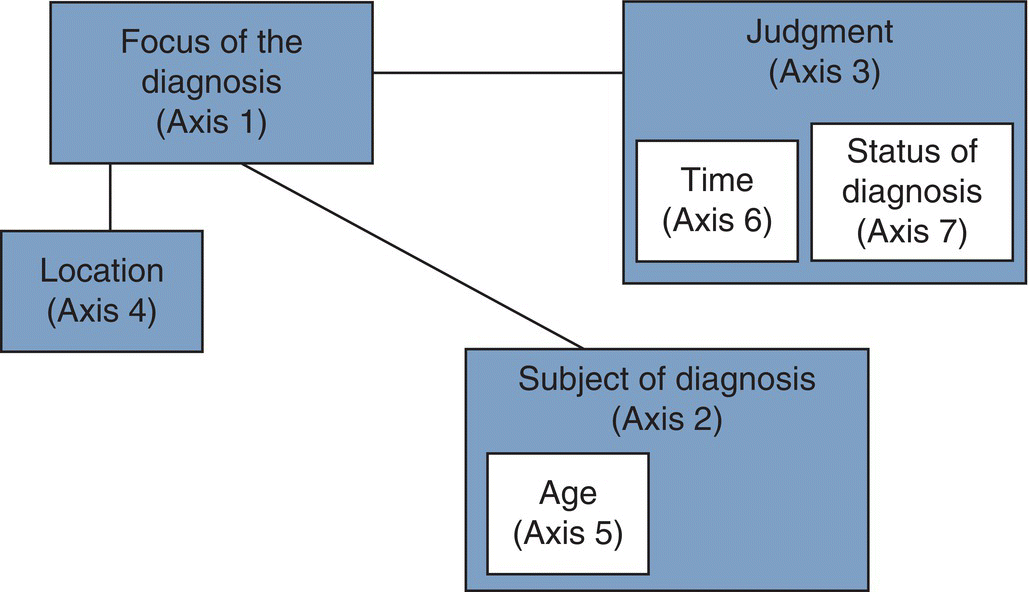Chapter 4 T. Heather Herdman, RN, PhD, FNI Taxonomy is defined as the “branch of science concerned with classification, especially of organisms; systematics; the classification of something, especially organisms; a scheme of classification” (Oxford Dictionary, 2013). Within a taxonomy, the domains are “a sphere of knowledge, influence, or inquiry”; and the classes are “a group, set, or kind sharing common attributes” (Merriam-Webster, Inc., 2009). We can adapt the definition for a nursing diagnosis taxonomy; specifically, we are concerned with the orderly classification of diagnostic foci of concern to nursing, according to their presumed natural relationships. Taxonomy II has three levels: domains, classes, and nursing diagnoses. Figure 3.3 (p. 58) depicts the organization of domains and classes in Taxonomy II; Table 3.1 (pp. 66–78) shows Taxonomy II with its 13 domains, 47 classes, and 235 current diagnoses. The Taxonomy II code structure is a 32-bit integer (or if the user’s database uses another notation, the code structure is a five-digit code). This structure provides for the stability, or growth and development, of the taxonomic structure by avoiding the need to change codes when new diagnoses, refinements, and revisions are added. New codes are assigned to newly approved diagnoses. Retired codes are never reused. Taxonomy II has a code structure that is compliant with recommendations from the National Library of Medicine (NLM) concerning healthcare terminology codes. The NLM recommends that codes do not contain information about the classified concept, as did the Taxonomy I code structure, which included information about the location and the level of the diagnosis. The NANDA-I terminology is a recognized nursing language that meets the criteria established by the Committee for Nursing Practice Information Infrastructure (CNPII) of the American Nurses Association (ANA) (Lundberg, Warren, Brokel et al., 2008). The benefit of using a recognized nursing language is the indication that it is accepted as supporting nursing practice by providing clinically useful terminology. The NANDA-I nursing diagnoses also comply with the International Standards Organization (ISO) terminology model for a nursing diagnosis (Figure 4.1). The terminology is also registered with Health Level Seven International (HL7), a healthcare informatics standard, as a terminology to be used in identifying nursing diagnoses in electronic messages among clinical information systems (www.HL7.org). Figure 4.1 The ISO Reference Terminology Model for a Nursing Diagnosis The NANDA-I diagnoses are concepts constructed by means of a multiaxial system. This system consists of axes out of which components are combined to make the diagnoses substantially equal in form, and in coherence with the ISO model. An axis, for the purpose of the NANDA-I Taxonomy II, is operationally defined as a dimension of the human response that is considered in the diagnostic process. There are seven axes. The NANDA-I Model of a Nursing Diagnosis displays the seven axes and their relationship to each other (Figure 4.2): Figure 4.2 The NANDA-I Model of a Nursing Diagnosis The axes are represented in the labels of the nursing diagnoses through their values. In some cases, they are named explicitly, such as with the diagnoses Ineffective Community Coping and Compromised Family Coping, in which the subject of the diagnosis (in the first instance “community” and in the second instance “family”) is named using the two values “community” and “family” taken from Axis 2 (subject of the diagnosis). “Ineffective” and “compromised” are two of the values contained in Axis 3 (judgment). In some cases, the axis is implicit, as is the case with the diagnosis Activity intolerance, in which the subject of the diagnosis (Axis 2) is always the patient. In some instances an axis may not be pertinent to a particular diagnosis and therefore is not part of the nursing diagnostic label. For example, the time axis may not be relevant to every diagnosis. In the case of diagnoses without explicit identification of the subject of the diagnosis, it may be helpful to remember that NANDA-I defines patient as “an individual, family, group or community.” Axis 1 (the focus) and Axis 3 (judgment) are essential components of a nursing diagnosis. In some cases, however, the diagnostic focus contains the judgment (for example, Nausea); in these cases the judgment is not explicitly separated out in the diagnostic label. Axis 2 (subject of the diagnosis) is also essential, although, as described above, it may be implied and therefore not included in the label. The Diagnosis Development Committee requires these axes for submission; the other axes may be used where relevant for clarity. The focus is the principal element or the fundamental and essential part, the root, of the nursing diagnosis. It describes the “human response” that is the core of the diagnosis. The focus may consist of one or more nouns. When more than one noun is used (for example, Activity intolerance), each one contributes a unique meaning to the focus, as if the two were a single noun; the meaning of the combined term, however, is different from when the nouns are stated separately. Frequently, an adjective (spiritual) may be used with a noun (distress) to denote the focus, Spiritual distress (00066). In some cases, the focus and the nursing diagnosis are one and the same, as is seen with the diagnosis of Nausea (00134). This occurs when the nursing diagnosis is stated at its most clinically useful level and the separation of the focus adds no meaningful level of abstraction. It can be very difficult to determine exactly what should be considered the focus of the diagnosis. For example, using the diagnoses of bowel incontinence (00014) and stress urinary incontinence (00017), the question becomes: Is the focus incontinence alone, or are there two foci, bowel incontinence and urinary incontinence? In this instance, incontinence is the focus, and the location terms (axis 4) of bowel and urinary provide more clarification about the focus. However, incontinence in and of itself is a judgment term that can stand alone, and so it becomes the focus, regardless of location. In some cases, however, removing the location (axis 4) from the focus would prevent it from providing meaning to nursing practice. For example, if we look at the focus of the diagnosis, risk for imbalanced body temperature (00005), is it body temperature or simply temperature? Or if you look at the diagnosis, disturbed personal identity (00121), is the focus identity or personal identity? Decisions about what constitutes the essence of the focus of the diagnosis, then, are made on the basis of what helps to identify the nursing practice implication, and whether or not the term indicates a human response. Temperature could mean environmental temperature, which is not a human response, so it is important to identify body temperature as the nursing diagnosis. Similarly, identity could mean nothing more than one’s gender, eye color, height, or age – again, these are characteristics but not human responses; personal identity, however, indicates one’s self-perception and is a human response. In some cases the focus may seem similar, but is in fact quite distinct: other-directed violence and self-directed violence are two different human responses, and therefore must be identified separately in terms of foci within Taxonomy II. The foci of the NANDA-I nursing diagnoses are shown in Table 4.1. Table 4.1 Foci of the NANDA-I Nursing Diagnoses
NANDA-I Taxonomy II: Specifications and Definitions
Structure of Taxonomy II

A Multiaxial System for Constructing Diagnostic Concepts

Definitions of the Axes
Axis 1 The Focus of the Diagnosis
Activity planning
Activity tolerance
Adaptive capacity
Airway clearance
Allergy response
Anxiety
Aspiration
Attachment
Autonomic dysreflexia
B
![]()
Stay updated, free articles. Join our Telegram channel

Full access? Get Clinical Tree

 Get Clinical Tree app for offline access
Get Clinical Tree app for offline access
